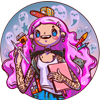How to successfully complete #inktober
Right now, see the author's works in Inktober 2025 "Old School Action Movie Heroes" on Boosty! Your subscription for a small amount will help our game.Read this article before calling Inktober a waste of time or an unbearable task! Wait, you haven’t even heard of it?! The annual drawing challenge which connects and unites artists from all over the world is taking place 17 time this year and keep gaining more and more fans. So it shouldn’t be that bad.
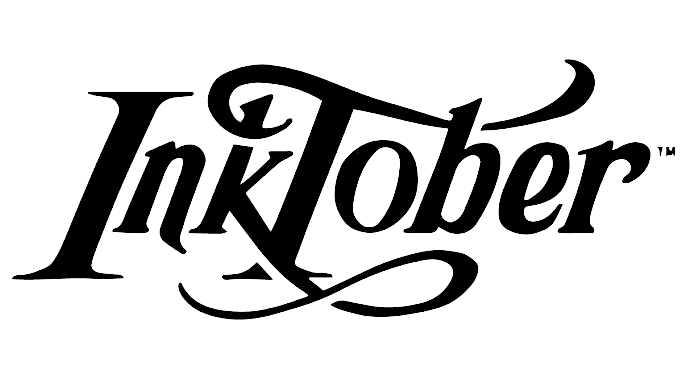
Inktober is……
In far 2009 the comics artist Jake Parker threw local art challenge for himself and his friends to improve his creativity and drawing skills in inking. Note: in the comics industry the artist who draws linework and the artist who do color are often two separate persons. Initially Mr. Parker wanted to improve specifically graphic skills so from the start Inktober involved the creation of black-n-white drawings.
At the core the idea of a challenge is to draw an art a day each day of a month. The event fell to be held in October so it got the name Inktober = Ink + October.
To give your fantasy a clue it was made a prompt-list with prompt words for each day. The words are picked randomly each year and can contain nouns, verbs, adjectives and even interjections as it has happened this 2022 year. These words serves ass a starting point for creating a theme or a plot for an art of a certain day.
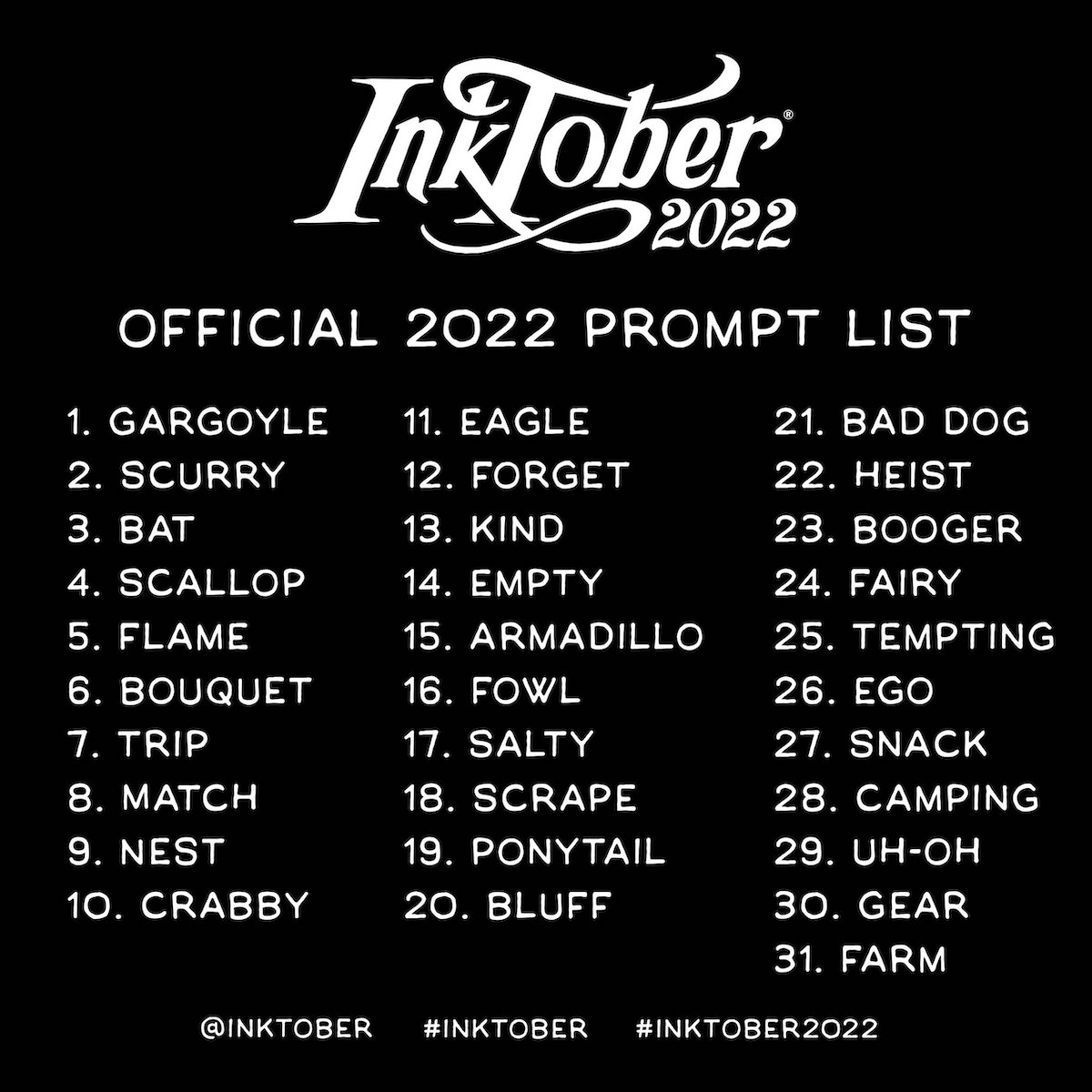
Inktober has no official social network platform. It’s known mostly for special hashtags, which it has some: general challenge tag #inktober then year of a challenge, for instance #inktober2022 and also prompt hashtags. These tags have many variants of inscription like #inktober2022gargoyle, #inktober2022_gargoyle, #inktober2022day1gargoyle.
You will certainly find these tags in Instagram, Twitter, Tumblr, Facebook, even VKontakte. It’s also widely represented with an art process videos and sketchbook tours on You-Tube, TikTok and so on.
I'll separately write about VK (VKontakte). In Russia, Inktober has evolved into an independent movement with prizes and organizers. Participation in it and in the official Inktober challenge are not the same. The Russian-speaking community uses the hashtags #инктобер and #инктябрь, as well as the prompts from the official list of the Russian translation.
While participating Inktober artists make arts and post them every day keeping in mind to accomplish posts with right tags. Your art posts should preferably match the prompt word of the day if you want to get visible. But if you don’t care much about hyping you are not forbidden to draw in any order you would like, not the order of prompt-list only.
From here, we move on to the main challenges that an artist will face when deciding to participate in the challenge and post without falling behind the schedule.
Inktober is difficult…
Initially Inktober was create to actively improve your daily drawing habit and to evolve your creativity, so it meant artists should draw their arts in the moment. Each image is created at the day, the prompt word fells out for. However it revealed soon, that such an approach made people burnt out too quick. Drawing each day of a month for whole month is a kinda luxury. There are plenty of people among participants for whom drawing is a hobby, they have jobs, families, chores n so on. That’s why hosts begun to publish prompt-list earlier, one month before the event.
The 1 September Inctober publishes its official prompt-list for the current year through all Social Media. That’s how it gives you time to prepare. It’s a splendid bonus but you should know how to use it. Many participants will get burnout, deflate and go off the distance long before finish even with such a gift. For some artists Inctober becomes a personal challenge. They set on work enthusiastically but face the raw of difficulties not obvious at the beginning, and finally fail. They turn back next year filled with hope to NAIL it this time!
I belong to this type of Inktober artists. My very first start was at 2018, when I stepped on all beginners rakes and could bear only 6 arts of 31. But already the next year I successfully finished the series dedicated the TV-show “Dark” (I tell this story in a YouTube video) simultaneously drawing another ones series (took 26 of 31). At 2020 I’ve been simultaneously drawing already 3 (!) series, one I’ve brought to the end and another two were hung up on 26 arts again (kinda enchanted number!). Finally at 2021 I’ve successfully managed and brought to the finish all 3 series! 4 of my series I’ve summary drawn for all Inktobers later evolved into 4 projects which are developing even now. The absolute headliner of scaling is series “Lords of the Streets” (2020). That’s the universe was used for interactive gallery on our site, collection of merch, comics and game.
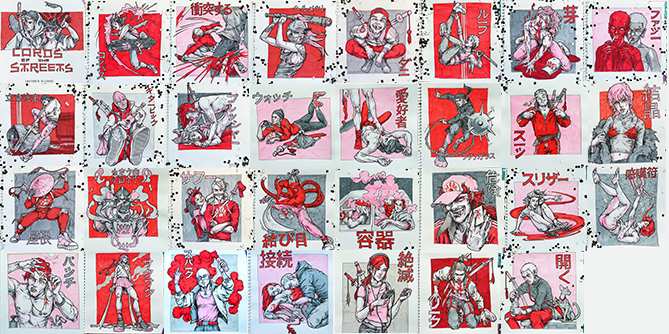
That’s why I can definitely say I’m an old hand at Inktobers. Here I share some of my hacks, tricks and unspoken rules I’ve worked out through these 4 years. They will be handy for any of you who firmly decide to conquer that art-Everest!
So how to complete Inktober?
Preparing: the Idea Level. Creativity and Brainstorming
Step 1: Prompt-list
First thing you ought to start with is a prompt-list. It’s usually published on 1 September, but It said to be given even earlier if you subscribe the info-letter on official site. But for me one month is enough.
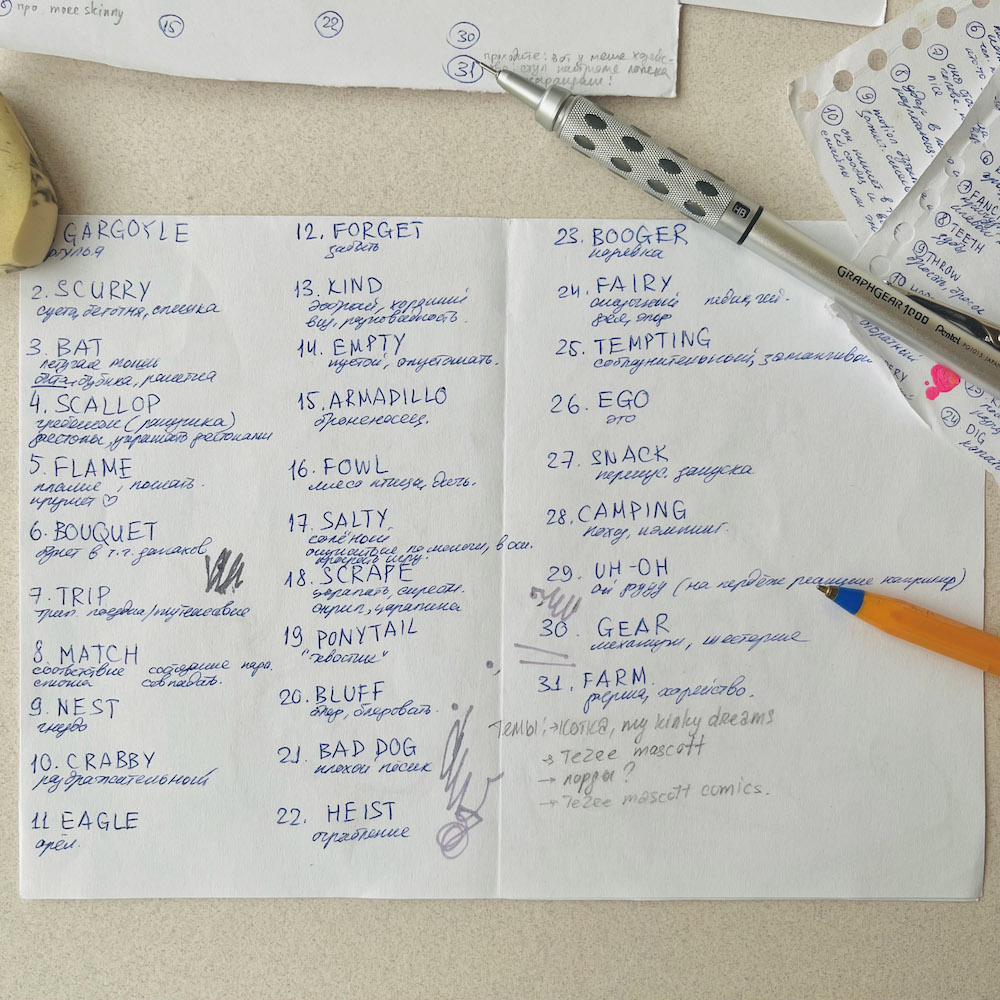
Write out and translate by yourself each word from the prompt-list once it’s published (if English is not your native language). Participants from other countries manage local communities where they post translated lists. But don’t rush to use it. Firstly, no one can assure you that people who translated the prompt-list know English well enough. Secondly some words in English have more than one translation. For instance word HUSKY in 2022 prompt-list can be translated as a dog breed Husky, in a meaning “husky, rude voice”, or as a “husky, chunky body constitution”. One word has 3 different meanings, but official fan communities mostly provide one most superficial variant. This fact can significantly decrease the variety of plots for your art. I mean not every prompt word is easy to come up with an idea of art.
I can suggest you a couple of translators besides Google, to say context-reverso or my favourite on a field of weird slang words — urban dictionary. Sometimes it helps me to find out some unusual translations for the dull and common words I’ve known from school course.
Step 2: plots
Now you have a llist of translated prompts right infront of you. Read it again and again; ponder it while having breakfast, or coffee break, while having a walk and bathing. Try to assocciate these prompt words with certain picture in your head. What plots are coming to your mind? As I've said for some words it will be easy to came up with an ideas, for some it will take time.
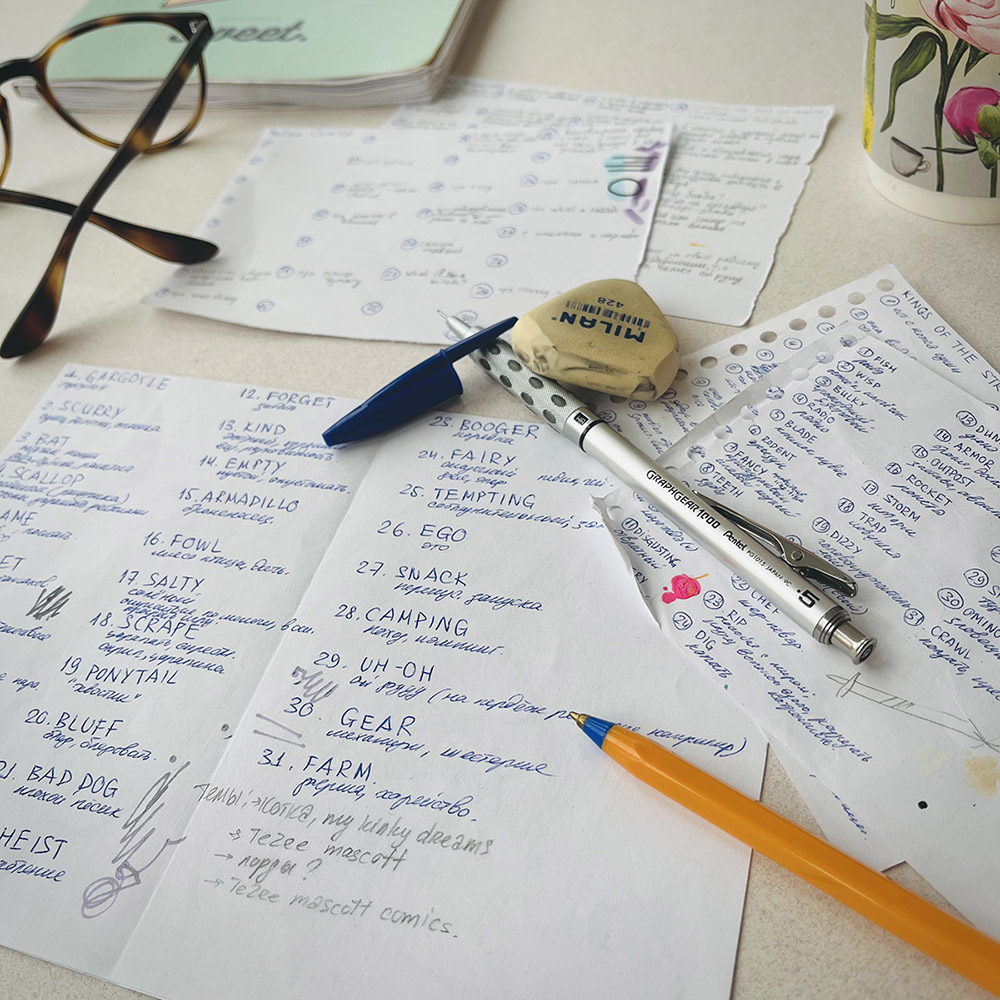
Prepare a sheet of paper of an appropriate size and write numbers from 1 to 31. As soon as an image for a specific prompt forms in your mind, quickly jot down a brief description next to the corresponding number in a way that, by reading this short pair of lines, you could mentally reconstruct the invented image. Do not overlook this step!
These written narratives, composed in this manner, will help you conserve energy by not needing to constantly hold concepts in memory, thus freeing up cognitive resources for further brainstorming. While you can develop artworks using only keywords, it's even better to create thematic series, which brings us to the next step.
Step 3: Choosing a Series Theme
The theme of a series is what will unite the artworks created during a single Inktober challenge into a stylistic and meaningful whole. Themes of my Inktobers have been pink cute marshmallow skulls (2020), street ninja hooligans (2020-2021), Victorian witches (2019), and more. When combined with the daily prompt, the theme provides a clear direction for drawing, partly shaping the narrative and compositional aspects from the start. This is a working hack that makes the creative task easier.
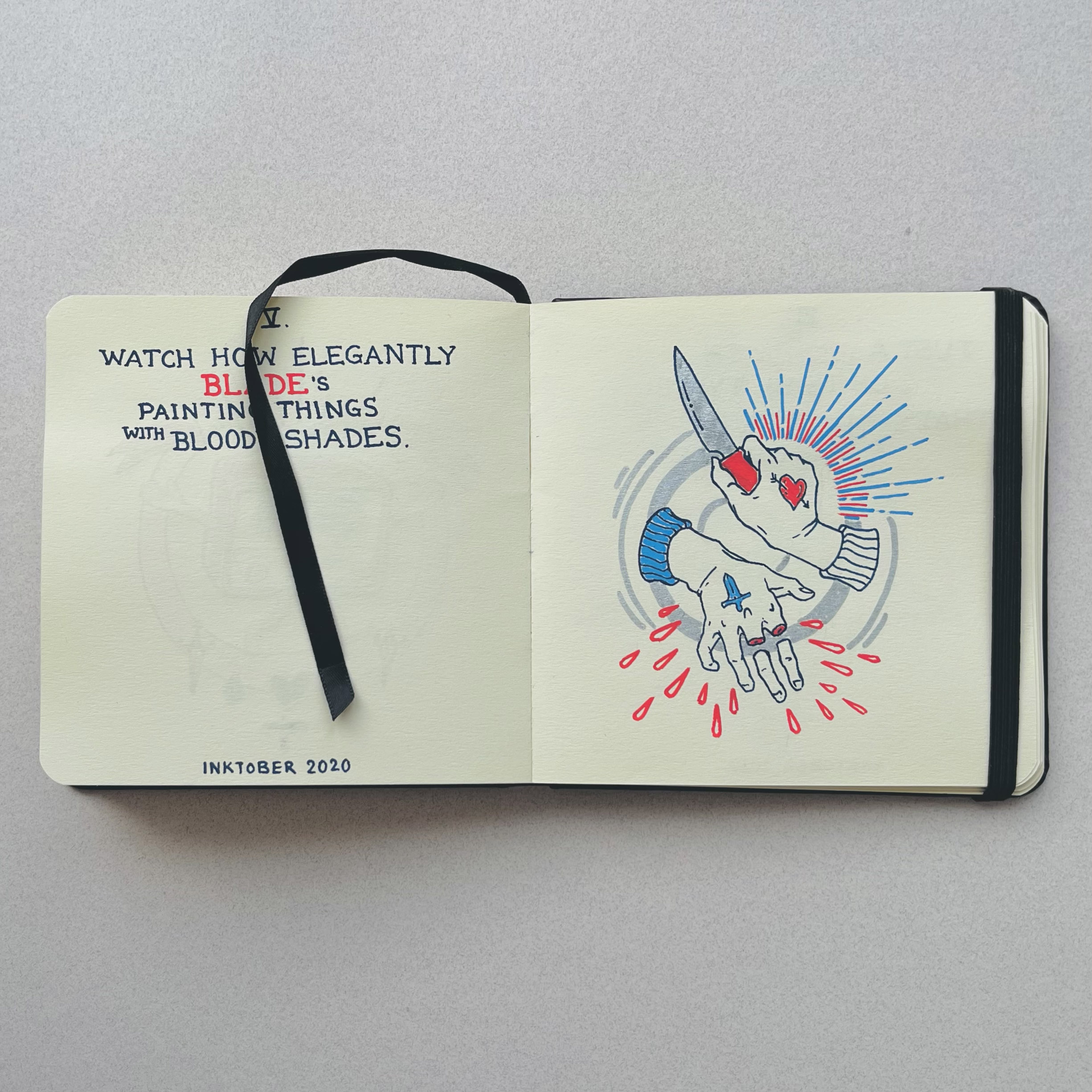
Additionally, the chosen theme will set you apart amidst the countless other artworks. Other participants of the challenge, while exploring tags, are more inclined to subscribe and follow artists with thematic series. If a series is captivating, observers eagerly wait for the release of new artworks.
However, when choosing a theme, it's important to understand that you'll have to create artworks for a whole 31 days based on it! It should be something truly yours, something you've been enjoying and passionate about for a long time. Even more — you need to be obscessed with this idea in order to successfully complete the challenge.
Believe me, if on the start you're burning with enthusiasm to draw on chosen theme, it might get much lower towards the end. However, if the theme only sparks curiosity at the beginning and you start the challenge with a thought like "well, I'll give it a try, practice a bit," you'll end up hating it by the middle, and you won't make it to the end. Verified.
But how do you decide on a theme if two, three, or even four options inspire you equally? And how do you know if the chosen theme and style fit well? This is where we go to practical preparation.
Preparation at the Material Level and Trial by Combat
Test Arts
Once you've worked through the previous stages of idea preparation, it's time to move on to implementation! Yes, you not only can, but you MUST start doing this in September already. The sooner you can manage the translations, narratives, and theme, the more time you'll have left. This is also a benefit that arises before the start, and it's necessary to use it right if you want to meet the deadline. Started drawing in September, you'll give yourself the opportunity to take a break in October and reduce the chances of burnout. When the time comes, you'll systematically and calmly post the prepared content while simultaneously continuing to draw ahead. Peacefully, without rushing and irritation.
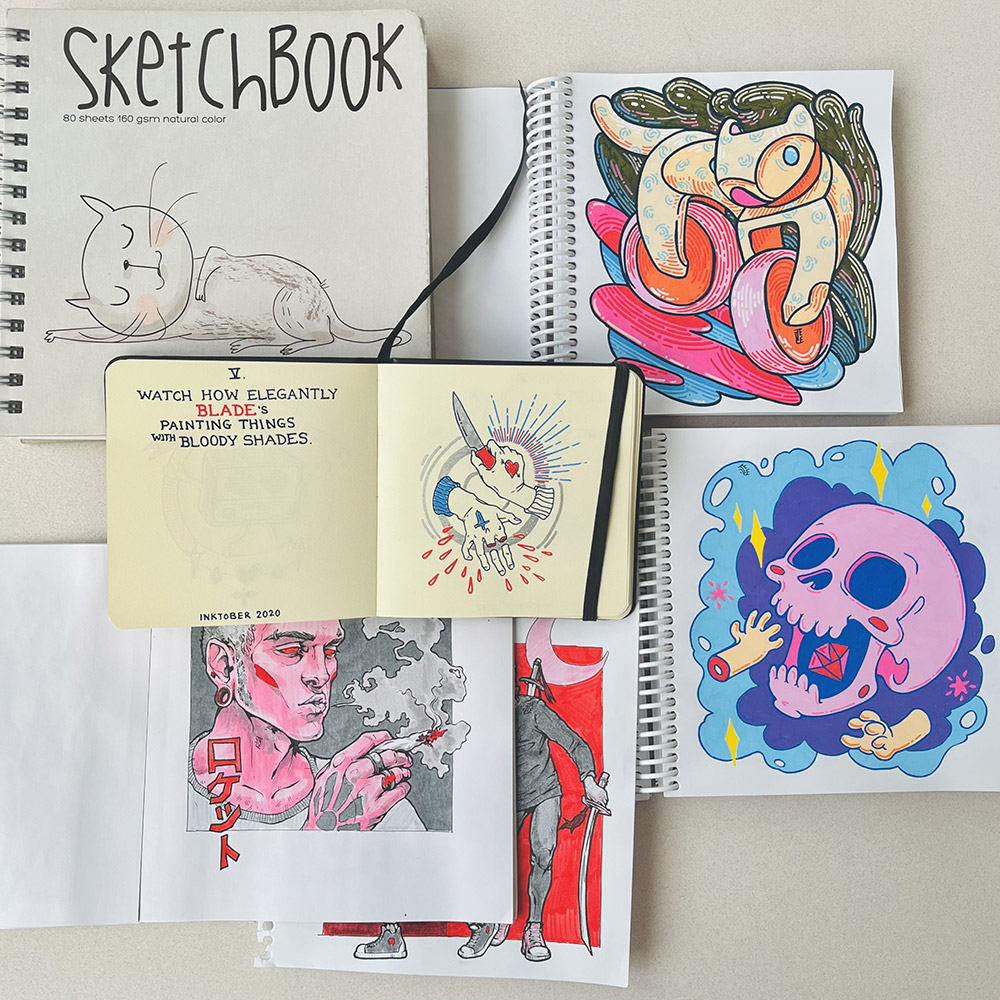
Before making your final decision on the chosen theme, try to create at least one artwork based on the plot you've create, using the method you've outlined.
You'll immediately realize how much effort and time it takes to create a single piece. This is a tangible check of the feasibility of your concept. If creating one artwork takes more than two days, it's a clear indication that you need to reconsider the concept. You've made a planning mistake, but for now, you have enough time to quickly fix it. Later, I'll explain what to keep in mind to minimize such errors.
Constraints
Despite the fact that they are not mentioned anywhere, constraints indeed exist! Drawing for 31 days in a row is challenging. So, if after the previous step, you find that creating one prompt takes more effort and time than you initially thought, it's time to establish some boundaries. The success of the series depends on the chosen style. The more complex the drawing is in terms of detail and composition, the higher the likelihood of failing the challenge.
Firstly, be honest in answer how much time you genuinely have for drawing and what your skill level is.
If you can dedicate only an hour or two per day, no more, and/or if you're a beginner in drawing, GIVE UP complex compositions and realism. This is a reasonable idea even for advanced artists. The truth lies in simplicity. Try a style of characters and objects that is manageable and familiar to you.
Secondly, reduce the amount of detailing. Avoid drawing loads of textures.
Curls of fur, the crackles of tree bark — wherever you can do without them. Instead, work on a generalized representation: for instance, indicate curls with round shapes, as cartoon clouds. Kinda. The simpler the stroke, the quicker it can be drawn technically. This way, you'll spend less time on drawing.
Thirdly, refuse of multi-planar compositions.
Often in Inktober narratives, backgrounds and depth are absent: the drawing depicts only one object that fits the prompt's requirements and the theme of the series. Alternatively, if a background and surroundings are indeed needed to convey context, try to simplify and avoid detailing them extensively.
Sizes
And again — less is better. Often, you think of drawings suitable for formats like A4. This is a dangerously large format for Inktober. Even A5 might turn out to be too big. Don't hesitate to draw small artworks; size and complexity don't determine beauty. On the Instagram profile of Inktober, you can find examples of tiny miniatures no larger than a coin.
One of my favorite sketchbooks for Inktober is the small square Art Creation sketchbooks. I've also drawn in A5 sketchbooks and square ones measuring 15-20 cm, but overall, my artworks fit within the dimensions of 15-17 cm on the longest sides. And regardless of the sketchbook I use, I leave empty space around the image; I don't try to fill up the entire page.
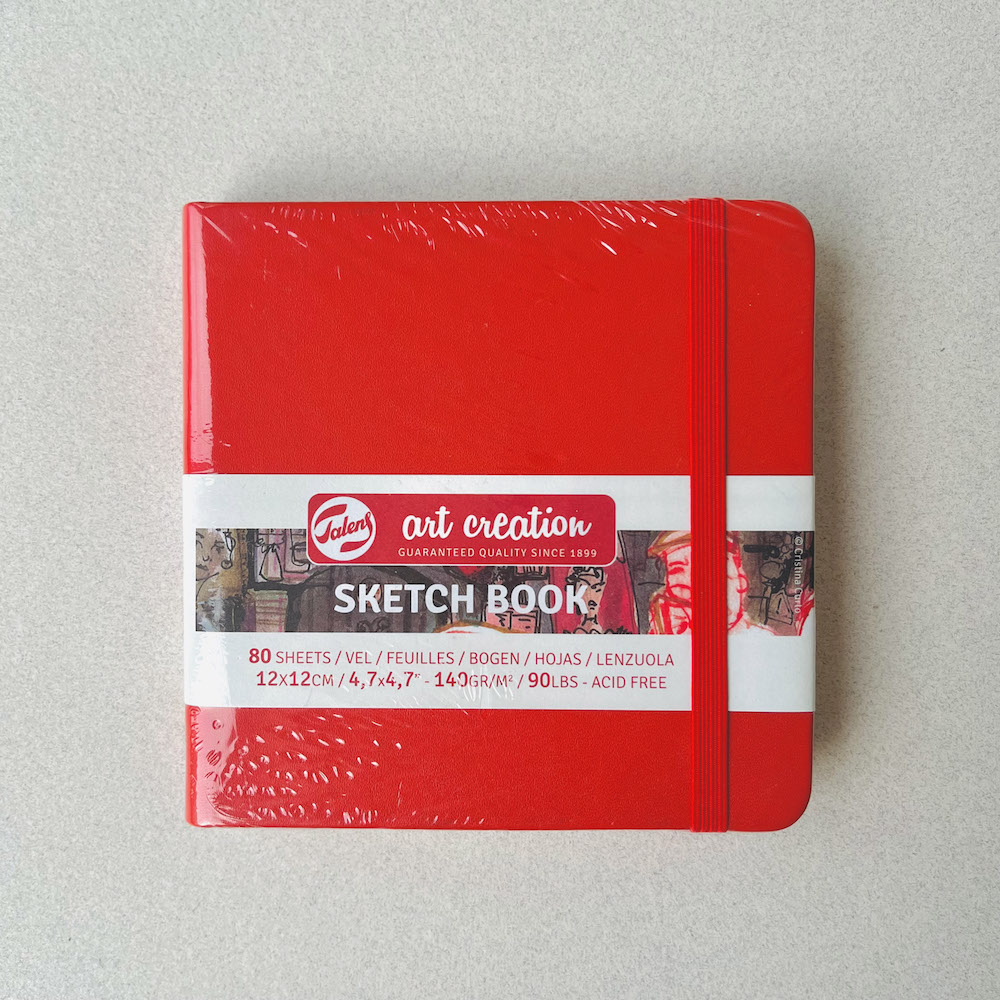
You can create even more inventive ways of conducting Inktober. Jake Parker himself once drew all the prompts on a single sheet, in the form of a conglomerate composition made up of small artwork elements.
Materials
For the challenge, I recommend using the graphic materials you're familiar with and confident in using. Inktober is not the time for experimentation in this area. Using unfamiliar materials, you risk either misjudging the time required or becoming disappointed with the results, leading to a loss of motivation.
You can create your graphics with fineliners and brush pens, or opt for brushes and ink.
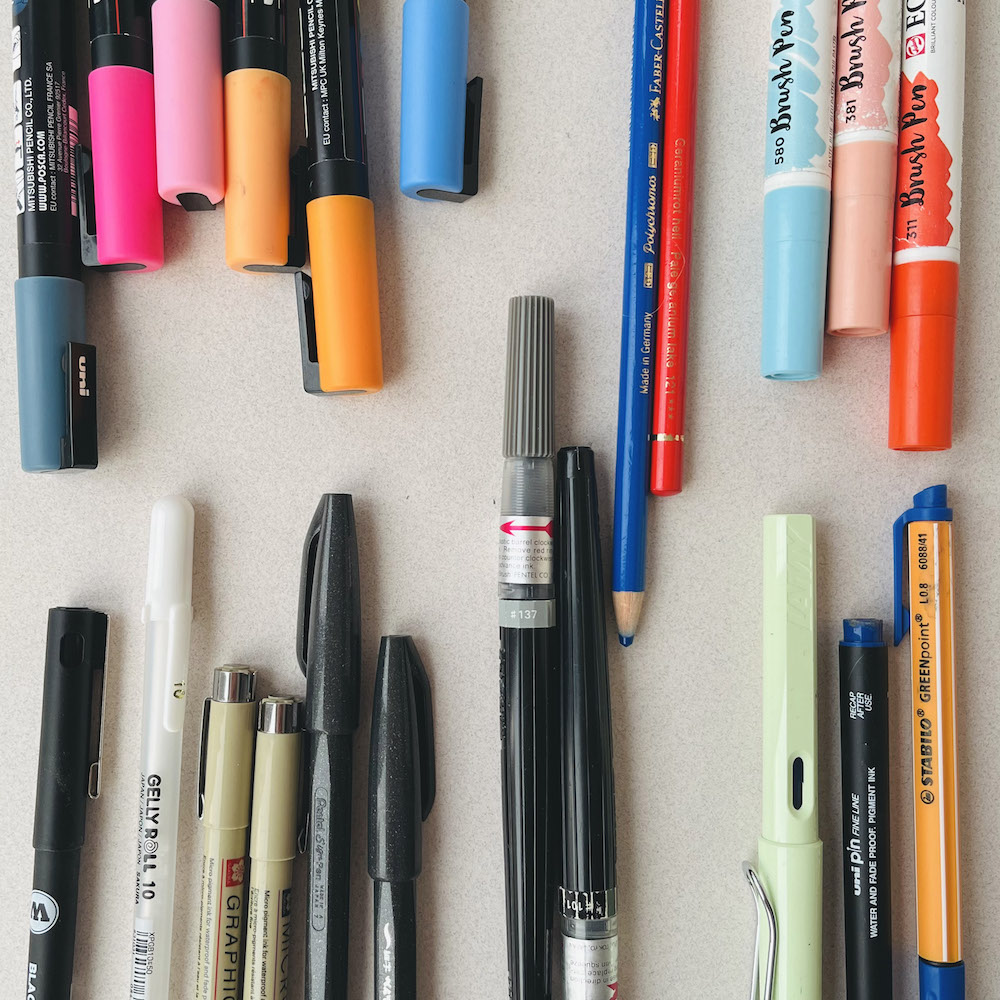
For different series, I've used various materials, but most often, I emphasize clean lines, which I achieve using Pigma Micron Sakura fineliners and graphic tools like Pentel brush pens and multiliners. To avoid concerns about paper bleed-through, I don't use alcohol-based markers, but I frequently use watercolor markers like Ecoline. They are predictable in drawing fillings and stains while retaining lightness and transparency. Additionally, I use acrylic markers like Molotow or POSCA Uniball for dense and opaque styles.
Black and White or Color?
Classically, Inktober involves working without color, although the official rules state that this isn't a defining factor. Using just black simplifies the task: you don't have to think about color schemes and appropriate color usage. However, in the last couple of years, there is step-off the straight black-n-white graphics we can observe.
As an alternative, you can replace black with another color. You can create red-and-white or blue-and-white artworks; they will still be graphically monochromatic, but this approach can help establish a foundamentals of style.
Another option is to use a single accent color in your black-and-white artwork. It can remain consistent throughout the series or change from artwork to artwork. I used this method in a series based on the TV show "Dark".
You can combine two or three chromatic colors, or even mor. There are Inktober enthusiasts who consider this "not authentic" but such criticisms are unwarranted. However, for several reasons, using fewer colors in your works is better.
Firstly, creating multi-colored paintings is more complex. You'll spend time contemplating combinations and color schemes; even mechanically switching between brush pens or paints will consume time. Therefore, if you decide to make a colored Inktober, try to work with at least a limited palette - choose a narrow range of shades to work with.
Secondly, just 2-3 years ago, the official Inktober social media pages only reposted black and white works. While the situation has changed and monochromatic works with color accents are now reposted, the preference still leans towards black and white. So, if you want to not only attract new followers to your platforms but also dream of being featured on the official Inktober profile, opt for black and white graphics.
Materials as Motivation
This funny thing isn't about rules but rather a note to keep in mind. You can draw Inktober on anything and with anything. An unconventional choice of materials can also work in your favor. For example, you can draw on supermarket receipts, craft paper bags, or even toilet paper! Moreover, you can go beyond the confines of drawing. An Instagram search will reveal examples of sculptural works, figurines, makeup; anything can become your unique twist!
Nonetheless, the act of purchasing materials specifically for this challenge can also serve as part of your motivation. It's a unique ritual, akin to buying new notebooks and pens for the first day of school. Every time you open this "special" sketchbook purchased for Inktober, uncapping fresh fineliners, you'll experience a light surge of pleasure.
Don't laugh – even these tiny drops of motivation will come in handy on this journey! You'll come to realize this by the middle of the challenge. Additionally, a clean sketchbook dedicated to a specific series motivates you to see how you will end it up.
The materials you buy don't have to be expensive. Most of the sketchbooks I've used for Inktober were purchased at stationery stores and cost around 100-150 rubles. I don't see the point in spending a lot of money on small drawings, but what's even more important is that the affordability of these sketchbooks alleviates the fear of the blank page and the pressure to create a masterpiece on the first try. Ideally, if the number of pages in your chosen sketchbook is slightly more than the necessary 31, you'll have room for trial and error while simultaneously anticipating the achievement of completing the sketchbook.
Why Inktober is beneficial for an Artist
— But why, and who needs it?
Participating in Inktober is beneficial. At the beginning of this article, I mentioned why Jake Parker himself started this challenge. That remains the primary reason: Inktober provides the opportunity to be a complete artist. It helps not only to improve drawing skills and imagination but also trains your practice of daily artistic work, fostering the idea that drawing is your life!
No matter how skilled you are in drawing, whether it's a hobby or a profession; Inktober will help clarify all questions and relationships with your creative side. Believe me, after it, you'll become a different person. You might not touch pencils and paper for a week… but soon you'll realize that drawing has become such a strong habit that it's hard to be without it now.
If you work in or aspire to work in the gaming, animation, or illustration industry, participating in the challenge is essential! The Inktober pipelines remotely resemble tasks that concept artists deal with; they teach you to generate numerous ideas and transform them into fast concept art pieces. You can even align your personal drawing goals with Inktober. For instance, if you need to improve your skill in drawing props or icons for work, make that your Inktober theme — and go for it!
— Are There Prizes?
On the official website, the creators state that Inktober is not a competition. There are no winners; there are only participants, and the focus is solely on participation. Generally you gain hype, a sense of involvement in the largest art flashmob on the internet, the opportunity to gain new followers on visual and video platforms, and to some extent, gain recognition.
Additionally, by observing Inktober, you can discover numerous new artists who can serve as inspiration and benchmarks. During the challenge, official Inktober pages regularly feature well-known artists from various creative fields, including comics and monumental art. They provide advice, tips, and drawing methods, as well as reviews of materials. The organizers of Inktober even host a podcast on Spotify. In other words, there's a wealth of useful information and plenty to learn from.
However, in recent years, the Inktober organizers have collaborated with manufacturers of drawing and related supplies. The mechanism for giveaways is similar to that used in art marathons. To participate, you need to follow sponsors and Inktober, post your artworks within the specified timeframe, and use the needed tags. This way, there's a chance to win.
It might not align perfectly with the original philosophy of the Inktober creators, but that's how things go sometimes. The popularization of events like this can lead to such things. Officially, Inktober has no prizes or winners. First and foremost, you're drawing for yourself and for the joy of it.
— If There Are No Prizes, Then What?
For the 13 years since its first season, Inktober has grown from a local art challenge to a viral art movement on the internet. At the time of writing this article, the official Inktober Instagram account has 1 million followers, and the hashtag #inktober has been used in 24.5 million posts. The organizers are vigilant in protecting the copyright of this movement. Using the Inktober logo for commercial purposes is illegal, as is referencing it for monetary gain.
For the most ardent Inktober fans, official merchandise is available, including t-shirts with the Inktober logo, phone cases, and enamel pins. Additionally, in collaboration with art supply manufacturers, branded sets of graphic materials are created: sets of different types of liners, watercolor and acrylic colored markers, ink, nibs, and sketchbooks. Yes you're paying for the brand. If you're interested, these items can be purchased on the official website.
— And What Comes Next?
So, the long-awaited day arrives, and you put down those pens and pencils with a sigh of relief, flipping through the sketchbook filled with 31 artworks drawn in one month… After a while, a sense of regret even washes over you that it's all over. But for those who have embraced Inktober fully, the challenge doesn't end there. The organizers have come up with a continuation of Inktober, a lighter version to keep you creatively engaged throughout the remaining year until the next Inktober. It's called #inktober52. It's similar to the classic Inktober, but here you publish one prompt per week. The intensity is reduced by a factor of seven. Sometimes, I take a look at these prompts if I want to warm up and find a thematic inspiration. However, the intensity and energy concentration are definitely not the same as the original challenge.
In my view, the main thing that an artist gains from the challenge is a ready-made set of ideas that can be developed and applied further. From my series of Inktober artworks, much more has developed afterward. Yes, some parts turned out to be experiments that went nowhere, but based on others, independent projects blossomed. For instance, one series—NSFW pin-up artworks—I continued and monetized through Patreon, and at the time of writing this article, there are 105 artworks in that series. Another series is the foundation for an interactive visual novel game. The third is useful for honing skills in Blender. Lastly, my favorite series, "Lords of the Streets," has sprouted numerous spin-offs and has led to the development of four projects at various stages of realization, from completed ones to those still in development.
Closing Thoughts
Inktober is worth giving a try. Take the plunge and give it a shot—maybe not the first time, but eventually you'll conquer it. Along this journey, artists discover themselves, their unique styles of expression, make new friends, and explore new horizons of creativity. Plus, no other form of learning charges you with such enthusiasm and zeal! In my opinion, that's already a substantial list of "pros." So start, continue, and here's to a successful completion!
